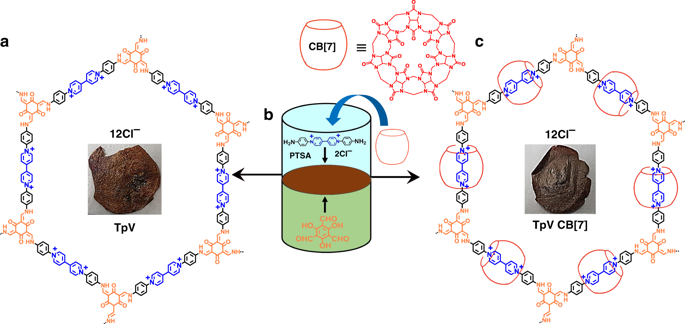Communications Chemistry ( IF 5.9 ) Pub Date : 2019-09-06 , DOI: 10.1038/s42004-019-0207-3 Gobinda Das , Sudhir Kumar Sharma , Thirumurugan Prakasam , Felipe Gándara , Renny Mathew , Nour Alkhatib , Na’il Saleh , Renu Pasricha , John-Carl Olsen , Maria Baias , Serdal Kirmizialtin , Ramesh Jagannathan , Ali Trabolsi

|
Since their initial presentation in 2005 by Yaghi and co-workers, covalent organic frameworks (COFs) have been the focus of much development. Here we introduce mechanical bonds into COFs by employing a method that involves supramolecular self-assembly, dynamic imine-bond formation, and liquid-liquid interfacial condensation and produces a continuous 2D polyrotaxaneted film. A diamino-viologen linker is complexed with the macrocycle cucurbit[7]uril (CB[7]) to form pseudorotaxanes that then condense with an aromatic tri-aldehyde core at the interface of two solvents. The unrotaxanated COF is prepared by condensing the viologen and the trialdehyde in the absence of CB[7], and the chemical and physical properties of the formed films are compared. The CB[7]–encapsulated film is mechanically and thermally more robust and more luminescent. The synthetic strategy presented here allows the incorporation of mechanically interlocked molecules (MIMs) into polymeric materials and provides access to materials that have properties and functionalities that are yet to be explored.
中文翻译:

基于紫精和葫芦丝的多轮烷共价有机网络[7] uril
自Yaghi及其同事于2005年首次提出以来,共价有机框架(COF)一直是许多发展的重点。在这里,我们通过采用涉及超分子自组装,动态亚胺键形成和液-液界面缩合的方法,将机械键引入COF,并产生连续的2D聚轮烷膜。将二氨基紫罗兰接头与大环葫芦[7]尿嘧啶(CB [7])络合,形成假轮烷,然后在两种溶剂的界面上与芳族三醛核缩合。通过在不存在CB的条件下将紫精和三醛缩合来制备未烷氧基化的COF [7],并比较了所形成薄膜的化学和物理性能。CB [7]封装的薄膜在机械和热方面更坚固,更发光。











































 京公网安备 11010802027423号
京公网安备 11010802027423号